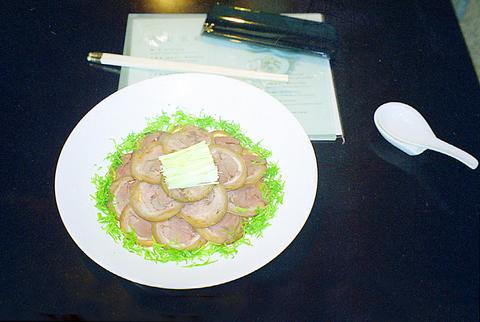To coincide with an exhibition featuring Tang Dynasty artifacts currently under way at Taipei's National Palace Museum, chefs at the Formosa Regent's Lan Ting (
While the stylish, slightly haut manner in which the food is presented may appear rather far removed from anything knocked up by Tang dynasty chefs, the dishes chosen by the chefs still remain representative of the flavors and styles of food eaten during the Tang dynasty.

PHOTO: GAVIN PHIPPS, TAIPEI TIMES
"It took us about a month to do the research, ask professors and ensure the dishes were as close as possible to those prepared during Tang times," said Formosa Regent's Daphne Wang (
The dishes are a mixture of cold and hot plates and soups, the most eye-catching of which is the stewed turtle soup chicken (NT$1,200). Served at the table complete with turtle shells, the dish, according to Wang is not very popular with the hotel's foreign guests, but is proving a big hit with local diners.
Diners who wish to enjoy a soup dish without the picturesque topping, are in for a treat, however, as both the braised chicken ball and vegetable soup (NT$200) and the braised sliced abalone soup (NT$300) are all guaranteed taste sensations.
For those with a passion for more down-to-earth Tang dynasty food, there's the marinated sliced lamb (NT$560) -- thin slices of lamb which are best dipped in the mild spicy sauce before eaten -- and the sauteed eel with bean sprouts (NT$560). The most popular dish with diners who wish to relive days of culinary yore is the sauteed beef and black bean (NT$520). The dish sees lightly cooked melt-in-the-mouth slices of beef topped with mild spices.
Vegetarians might be advised to avoid Tang food, however, as with the exception of sauteed celery in vinegar (NT$500) and sweetened wild rice with lotus seeds (NT$200) all of the dishes contain some form of meat.
To add an interesting twist to the dining experience, each individual dish also has its own story as to its how and why. While the hotel has yet to print English-language explanations of the food, should diners be curious as to the historic significance of their chow then restaurant staff will be only to happy to enlighten them.

May 26 to June 1 When the Qing Dynasty first took control over many parts of Taiwan in 1684, it roughly continued the Kingdom of Tungning’s administrative borders (see below), setting up one prefecture and three counties. The actual area of control covered today’s Chiayi, Tainan and Kaohsiung. The administrative center was in Taiwan Prefecture, in today’s Tainan. But as Han settlement expanded and due to rebellions and other international incidents, the administrative units became more complex. By the time Taiwan became a province of the Qing in 1887, there were three prefectures, eleven counties, three subprefectures and one directly-administered prefecture, with

It’s an enormous dome of colorful glass, something between the Sistine Chapel and a Marc Chagall fresco. And yet, it’s just a subway station. Formosa Boulevard is the heart of Kaohsiung’s mass transit system. In metro terms, it’s modest: the only transfer station in a network with just two lines. But it’s a landmark nonetheless: a civic space that serves as much more than a point of transit. On a hot Sunday, the corridors and vast halls are filled with a market selling everything from second-hand clothes to toys and house decorations. It’s just one of the many events the station hosts,

Among Thailand’s Chinese Nationalist Party (KMT) villages, a certain rivalry exists between Arunothai, the largest of these villages, and Mae Salong, which is currently the most prosperous. Historically, the rivalry stems from a split in KMT military factions in the early 1960s, which divided command and opium territories after Chiang Kai-shek (蔣介石) cut off open support in 1961 due to international pressure (see part two, “The KMT opium lords of the Golden Triangle,” on May 20). But today this rivalry manifests as a different kind of split, with Arunothai leading a pro-China faction and Mae Salong staunchly aligned to Taiwan.

Two moves show Taichung Mayor Lu Shiow-yen (盧秀燕) is gunning for Chinese Nationalist Party (KMT) party chair and the 2028 presidential election. Technically, these are not yet “officially” official, but by the rules of Taiwan politics, she is now on the dance floor. Earlier this month Lu confirmed in an interview in Japan’s Nikkei that she was considering running for KMT chair. This is not new news, but according to reports from her camp she previously was still considering the case for and against running. By choosing a respected, international news outlet, she declared it to the world. While the outside world